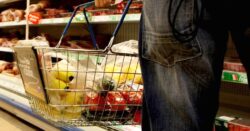Inflation is back at the 40-year high it hit earlier this year after a brief dip (Picture: PA)
Inflation is back up to a 40-year high after official data confirmed the cost of living crisis is only getting worse.
The rate at which everyday goods are getting more expensive is up to 10.1%, back into double-figures after a small dip in recent months.
Inflation is calculated by working out the cost of a hypothetical ‘basket of goods’, things most of us use in our everyday lives, and comparing it to how much the same things would have set you back 12 months ago.
While it’s a good general measure, inflation impacts us all differently depending on what types of things we spend our money on and some prices are rising faster than others.
Here are the main things driving inflation – and there’s a bit of good news too.
Food
Food and non-alcoholic drinks have been getting more expensive for a long time and that trend is continuing, the Office for National Statistics (ONS) says.
In fact, prices on supermarket shelves were one of the single biggest drivers behind inflation over the last month, well above the rate in other parts of the economy.
Food has gotten more expensive for the past 14 consecutive months and jumped sharply from 13.1% to 14.6% up to September, which is believed to be the highest rate since 1980.
The biggest rises are being seen in staple goods like bread, cereals, meat, milk, cheese and eggs.
The cost of food continues to be one of the biggest pressures on household budgets (Picture: REX/Shutterstock)
Hotels
Another big driver behind inflation in the last month is the rising cost of booking a room in a hotel.
The price of overnight stays had fallen in August 2022 but rose by 3.6% up to September 2022.
This time last year, hotel costs in the UK were plummeting by September so this rise suggests higher costs may be here to stay.
Transport
There’s good and bad news in the data for transport depending on how you get around.
After hitting record highs, the rising cost of filling up a car has slowed slightly, but is still far more expensive than it was a year ago.
Petrol and diesel prices stood at 166.5p and 181.6p per litre on average in September 2022, compared with 134.9p and 137.4p a year earlier.
Rising prices at the pump have started to ease but are still much higher than last year (Picture: AFP)
So while it hasn’t suddenly become affordable at the pump, prices fell by 8.7p per litre on the month and diesel prices fell by 5p.
There was some more good – if expected – news on the cost of flying, with air fares dropping by 25% against the exorbitant fees being charged over the busy summer period.
That said, prices were still 35.7% higher than a year earlier, with the largest increases coming from domestic and European flights.
Elsewhere, the post-pandemic rush for second-hand cars has eased slightly, with the rate of inflation in prices almost halving in a month, the sixth in a row in which it has fallen.
Housing
Housing and the costs associated with the upkeep of a home have also risen, up by an eye-watering 20.2% compared to last year.
Private rents were one of the main drivers, including other general services like cleaning and DIY.
Energy prices were unchanged between August and September but the cost of getting kerosene delivered for people who aren’t on the gas grid soared by 13.6%.
The cost of furniture and household goods is also up by 1.5%.
What else is getting more expensive?
Other areas which have seen smaller rises include clothing and footwear, which are 8.5% more expensive than they were last year.
Alcohol and tobacco has also continued to get pricier, along with health products.
Get in touch with our news team by emailing us at [email protected].
For more stories like this, check our news page.
These are the common household items and expenses which are getting more expensive by the day.





